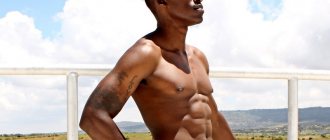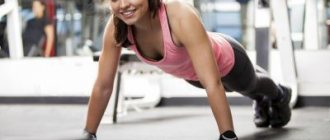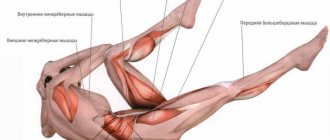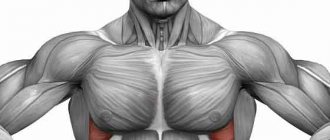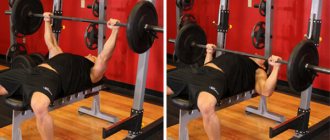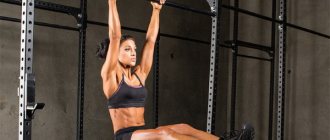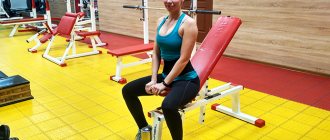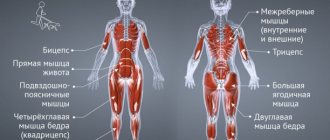Share:
Dips are a widely known and fairly accessible exercise. There are beams in almost every yard; such activities do not require any investment. Today we will talk about what muscles work, the correct technique for doing dips, how you can replace this exercise, as well as various variations of the exercise for both beginners and advanced athletes.
It is impossible to do push-ups on the uneven bars correctly; any technique will be correct, provided that you perform each movement correctly and under control. Another question is which muscles you want to focus on: the triceps or the pectorals. Looking ahead, we will say that a well-designed uneven bars training program should consist of both options. For those who can do 20 or more dips, it is advisable to perform this exercise with additional weight.
Pros and cons of the exercise
Main advantages:
- Give a significant load on the chest and triceps.
- They involve a large number of muscle fibers (almost all groups of the upper body).
- The ability to progress endlessly, regardless of physical fitness level (using weights).
- Significant increase in strength and endurance.
- Building natural muscles and improving definition.
- Strengthening tendons and ligaments.
- Not only does it not create a negative compression effect on the vertebrae, but it also relieves muscle hypertonicity due to being in a hanging position.
- Another important feature of chest-style dips is that the pectoralis major receives additional stretching. This promotes muscle growth and improved posture (by turning the shoulders back).
The exercise has no obvious disadvantages , except for the need to perfectly follow the technique. Often athletes perform bench presses at a fast pace with an emphasis on the number of reps. This is only justified from a competitive point of view (when the goal is to do the maximum number of repetitions). For developing strength, mass and endurance, this option is less effective than concentrated movement at a moderate pace.
What muscle groups are pumped when exercising on parallel bars (diagram)
Bars are one of the popular sports equipment found on most sports grounds, both outdoor and indoor. The projectile consists of two parallel crossbars located at a distance of 60 cm from each other on racks. Exercises on the uneven bars are mainly multi-joint and when performed, many core muscles are pumped at the same time.
The main muscles that parallel bars training is aimed at developing are:
- pectoralis major and minor muscles;
- triceps muscles or triceps;
- deltoid muscles - the anterior muscles of the shoulders;
- trapezius and latissimus dorsi muscles;
- biceps brachii or biceps.
The easiest way to pump up your chest and triceps muscles is on the uneven bars.
Also, while working on the uneven bars, you can perform some types of exercises to work the abdominals.
Parallel bars are a great way to strengthen your upper body and are suitable for both men and women. There is an opinion that even by training only on parallel bars, without using a barbell, horizontal bar or block exercise machines, you can get your torso in excellent condition. But you need to practice on the uneven bars correctly. And if intensive muscle growth is necessary, then various weighting agents should be used.
What muscles work when doing dips?
The parallel bar press is a basic exercise. This is a universal movement that is used to pump different muscle groups. Minor changes in technique can influence which muscles are used in dips.
- Chest muscles (mostly large).
- Triceps (emphasis on the long head).
These areas bear the main load (it can be changed by changing body position). Additional load and role in stabilizing the position of the arms and body falls on:
- Rotator cuff muscles.
- Front delts.
- Small pectorals.
- Serrated.
- Diamond-shaped.
- Trapezoid (lower part).
- Buttocks and abdominal area (work statically to stabilize the body).
The uniqueness of the movement lies in the fact that it applies to two different muscle groups at once. Despite the same type and similar technique, triceps and chest dips are different exercises.
What muscles are we loading?
The triceps, that is, the muscles of the back of the shoulder, work the most when doing dips. Their task is to move the elbow joint from a bent position to a straight one. This action is the main one when doing push-ups. The main effort is aimed at moving from the bottom to the top position on the uneven bars. It does not matter how the body is positioned or what position other parts of the body are in; the triceps is inevitably loaded as the elbow joint extends.
Secondly, when performing this exercise, the pectoral muscles are trained. They act as synergists and can be involved in the work to varying degrees. This is regulated by the position of the body and elbows. When performing the exercise, you can transfer more load to the chest, releasing the triceps a little, and vice versa. Since the pectoral muscles have greater strength, they are always included in the work if the triceps themselves are not able to withstand the load.
The main purpose of the pectoral muscles is to bring the shoulders forward. To use them when doing dips, you should do this exercise so that your shoulders move from a wider position to a narrower one. Depending on the goals that the athlete sets for himself, he can choose a push-up technique aimed at strengthening the triceps or strengthening the pectoral muscles.
Additionally, when doing push-ups on parallel bars, the load falls on other muscle groups, for example, on the anterior deltas. In addition, the shoulder ligaments are also trained. The condition of the entire shoulder girdle must be stable to perform the exercise, since it is responsible for holding the entire weight and moving the body up and down.
High load on the shoulder ligaments significantly increases the risk of injury when performing the exercise. Of course, there can be no talk of any push-ups if there are untreated injuries to the shoulder, elbow or wrist. First - full recovery, then - classes.
When performing push-ups, other muscle groups are also involved: the back, abs and some small muscles. If you do push-ups with your legs tucked, you can train your buttocks and thighs.
The influence of grip width on muscle development
The width of the grip determines the emphasis of the load on the muscles.
- If the bars are wide apart, this is a variation of the parallel bars for the pectoral muscles. It is considered more technically difficult and requires better physical preparation.
- Dips to work the triceps are performed with a narrow grip. A simulator in which the crossbars are located closer to each other is suitable for this.
If there is only one exercise machine in the gym and on the playground and the width of the bars cannot be changed, the emphasis can be shifted to different muscles by tilting the body.
Wide grip dips
It is not entirely correct to consider the technique of push-ups on parallel bars with a wide stance of the arms as an option exclusively for the chest. This is due to the fact that a considerable part of the load falls on the front delta (as in other presses).
The technique is considered one of the most difficult, and therefore is not suitable for beginners (with weak muscles, you can easily get a sprain in the chest area).
Another difficulty when working with a wide grip is accessing the uneven bars. It also requires certain dexterity, technique and physical preparation, so beginners are always recommended to start with machines with narrow bars.
Close grip dips
This type of work is considered classic, regardless of goals and shifts in emphasis. With a narrow arm position, the athlete is able to perform more repetitions and sets, increasing training volume and efficiency. This ensures faster progression.
It is important to consider that, unlike wide-grip dips, narrower hand placement increases core stabilization. Shifting the emphasis to the chest or triceps in this case is done by changing the position of the body.
Execution technique
Acceptance of the starting position
The exercise is performed in support on the uneven bars. To accept it, you must:
- take the parallel bars with a medium grip, palms facing each other;
- by lightly jumping with your legs, take a standing position;
- move your shoulders away from your ears, relax your trapezius;
- place the body vertically so that it stands stably in the bars
The starting position can also be taken from a stand if the projectile is high and it is not possible to jump into a standing position without overloading the shoulder joints. Push-ups in the gym are performed on standard racks that have foot rests. If the exercise is done with a weight attached to the belt, it is advisable not to take the starting position on the uneven bars with a jump, so as not to injure your shoulders.
Movement
Lowering the body occurs with inhalation. You need to inhale slowly and lower your body under control in one movement, elbows bent together. Exhalation occurs with effort. Having lowered your body until your forearm is parallel to the floor, you should exhale sharply and, as it were, “squeeze” your body up. Next, the entire planned series of push-ups is performed, and the athlete places his feet on the bars and carefully returns to the starting position. During movement, you need to focus on the work of the triceps.
Attention
A technical mistake is to slouch your shoulders forward and perform the exercise with a round back. This is dangerous because when you slouch, the shoulder joints are overloaded, and the person risks injuring the ligaments.
There is no need to “insert” your elbows as on a competitive bench press, this overloads the elbow joints and when performing other high-repetition work on the elbows (presses in machines, with a barbell and with dumbbells), it can lead to injury;
“Throwing” the body down is also a mistake and can lead to injury. In addition, the lack of control during the lowering phase does not allow the athlete to effectively work out the muscles.
Raising the elbows to the sides in the triceps version of the press is not allowed, since the athlete thus shifts the load on the pectoral muscles.
Recommendations
- Preliminary joint warm-up and light stretching of the triceps, anterior shoulder and biceps are mandatory;
- Each athlete must find an adequate depth of descent for themselves, comfortable for the shoulder joint, and convenient anthropometrically. Push-ups that are too deep can cause hyperextension of the ligaments.
- You can consciously press your elbows to your sides, this will remove excess stress from the muscles of the shoulders and chest, and shift the work to the triceps.
- It is important to stop at the bottom point, contract the muscles, and avoid inertia in the movement in order to get more targeted work;
- Straightening your legs will help avoid swaying and excessive leaning forward. With your knees bent, it is easier to perform the “chest” rather than the triceps version of this exercise.
It's DIPS, baby! (for BREASTS)
Technique for push-ups on the pectoral muscles
This exercise is recommended for developing the pectoral muscles. It gives a powerful load and additionally stretches the muscles.
Technique:
- Step onto the bars and get into position. Lean your body forward, tilting your head slightly. Bend your legs at the knees (this will further increase the degree of inclination).
- Begin to slowly lower yourself down without changing your body position. Movement occurs only in the shoulder and elbow joints.
- When your elbow is bent at a right angle, without pausing, return to the starting position, pressing your body up.
At the top point when working on the chest, it is recommended not to fully extend the elbow. This will reduce stress on the triceps and increase the efficiency of the movement for the target muscle.
Types of push-ups
Exercises performed on parallel bars are not as versatile as it might seem. All variety can be reduced to push-ups for the pectoral muscles and triceps.
A parallel bars training program does not necessarily have to include both types of push-ups, since it is still better to pump up your chest in the gym with the help of presses and dumbbell raises at different angles.
It is more convenient to pump the triceps already mentioned above on the uneven bars, but active load on them, especially when working with weights, can lead to pain in the elbows. Therefore, if you train outside rather than in the gym, it is better to evenly distribute the load across all muscle groups. That is, swing both your arms and chest on the uneven bars.
Let's look at both push-up options separately.
Triceps push-ups
The diagram of dips on the uneven bars for training the triceps is as follows:
- Elbows pressed to the body, body perpendicular to the ground (try not to lean forward with your nose).
- You should not go down too much, just bend your elbows to a right angle. At the lowest point, the load goes to the shoulders and chest.
- Partial straightening of the arms at the elbows is allowed. Fully straightening them when working with weights can lead to pain.
To make push-ups comfortable, you need to find bars the distance between which corresponds to the width of your shoulders.
Non-parallel bars are common in new gyms. That is, they narrow relative to each other on one side, and, accordingly, expand on the other. There is no unambiguous convenience here - for some it is convenient, but for others not so much.
But you can choose the width you need in any situation, and also rotate the brush in the way that is most comfortable for you. By the way, a slight pronation of the arms will be very useful, as it reduces the load on the elbows.
Wide bars are better for pumping up the chest. For training triceps, the best option is narrow parallel bars.
Push-ups
Push-ups for chest training have the following features:
- You need to tilt your body slightly forward and place your elbows to the sides.
- You should lower yourself low (do this carefully, paying attention to the sensations in your elbows and shoulders).
Simply put, your task is to lean forward and sink deeply down. If you do not tilt your body, you will mainly work on the upper chest. Leaning forward will engage the remaining parts. The wider the elbows, the lower the area of pumping the pectoral muscles.
The most important thing is to feel your muscles. Then you will determine an individual way of doing push-ups so that the part of your chest you need works. If you have a hard time feeling which muscles are working, then expect pain after training - it will tell you what exactly you worked.
A dip routine does not have to include both types of exercises.
Universal type of push-ups
Most often they do push-ups on parallel bars like this:
- We stand with straight arms on the uneven bars. There is no need to tilt your body; your legs are crossed or pressed tightly against each other. The position of the elbows is average, as comfortable as possible for you.
- You can lean forward a little. We go down all the way (the range of movements will be different for everyone, it all depends on the mobility of the joints and the elasticity of the tendons).
- After reaching the bottom point, we go up using the strength of the triceps and pectoral muscles. We try not to sway, as inertia will appear at the exit, which will push the legs forward. We also try not to move our legs back while lowering, otherwise the inertia during movement will be greater.
Rest between sets for as long as you need if you are doing your maximum. And 60-90 seconds if you work according to an individual plan. These push-ups give overall even development to your torso.
Triceps dip technique
This type of dip is used to shift the load on the triceps. The chest also takes part in the movement, but to a lesser extent than when tilting the body.
Technique:
- Exit and take the starting position. The arms should be fully straightened, the body forms a straight line, perpendicular to the floor.
- Slowly lower your body down, bending your arms.
- At the bottom point, take a minimal pause and return to the starting position.
Unlike the chest technique, in this variation it is important to straighten your elbows completely. This will allow you to maintain concentration on the triceps muscle and use it as much as possible during the movement.
Pectoral muscle training
Since the pectoral muscles work to bring the shoulders together, it is necessary to take a position on the uneven bars so that exactly this action is performed. To do this, your elbows need to be slightly moved apart, and your body should have a slight tilt forward. The greatest force is placed on the lower chest. Here the muscles are stretched to the maximum, which allows you to work with good amplitude and high efficiency.
The distance between the bars when training the pectoral muscles should also be slightly wider than the shoulders. If the bars are too wide apart, they can cause injury.
An exercise to strengthen the pectoral muscles is performed according to the following scheme:
- Having jumped onto the uneven bars, you need to take the starting position: your elbows are slightly apart, your body is tilted forward by about 30°.
- Inhaling, you need to lower your body. In this case, the elbows diverge to the sides, but not too widely - as far as the mobility of the joints allows. The maximum stretch of the chest muscles is felt at the bottom of the movement. You should try to maintain a 90° angle at your elbows.
- Tightening your chest muscles, you need to lift your body to the starting position. In it, you need to tense your chest as much as possible and fix this position for 1-2 seconds.
Similar to triceps training, work on the pectoral muscles should include 3-4 approaches. In each of them you need to do 10-15 push-ups. When the exercise is done confidently enough, you can move on to using weights. It is recommended to do this exercise after bench presses.
Features of push-ups on uneven bars with weights
You should only switch to dips with additional weight after your bodyweight progression has slowed or stopped altogether. There is no point in performing a movement in a high-repetition style, except for competitions for the maximum number of repetitions or endurance training. If the goal is to increase strength or mass (for which weights are used), the greatest effectiveness will be achieved by working in a mode of 6 to 12 repetitions.
The technique when performing push-ups on uneven bars with weight does not change and depends on which muscle needs to be loaded:
- Chest – with the body tilted forward.
- Triceps - body in an upright position.
A weight or pancake is used as weights. The weight is hung on the belt using a hook or clamp immediately before the start of the set. Removed immediately after finishing the approach.
Tips for performing push-ups
Improperly performing dips on the uneven bars can reduce the effect of this exercise, or even lead to muscle injury. Therefore, when working on uneven bars, you should adhere to the following tips:
- When standing on parallel bars, you should not allow your wrists to bend. It is necessary to hold firmly and stably on the crossbars;
- The spine should always remain straight. To maintain it in this position, you need to use the strength of the back muscles and abs;
- Sudden movements should not be allowed. Lowering and raising the body should be smooth and slow. This forces the muscles to work harder, but at the same time reduces the risk of injury;
- the bars must be installed slightly wider than shoulder width. Too large a distance between them will not provide a training effect, and will significantly increase the risk of injury;
- The exercise must be preceded by warming up all the joints involved: shoulders, elbows and wrists;
- You cannot relax your muscles and joints at the lowest point. Every action must be strictly controlled.
Dips are a simple but very effective exercise. If you approach their implementation correctly, the growth of the muscles of the chest and shoulder girdle will not take long. At the same time, joints develop, ligaments are trained, and the overall tone of the athlete increases. And if you do this exercise in the fresh air, it will be just great for your health.
Dips with elastic band
There are two options for using rubber bands.
- One allows you to ease the load in order to correctly do push-ups on uneven bars at a low level of physical fitness (used by beginners).
- The second option is used to increase the load (instead of weights).
To reduce the load
- Secure the rope between the beams so that it hangs in the form of an open loop.
- Step onto the parallel bars and lower your shins onto the rope. This will relieve some of the stress from pushing the body out and make movement easier.
To increase the load
Hook the ends of the rope onto the bars, passing the loop over your shoulders behind your neck. When performing movements in the negative phase, the tourniquet will create additional resistance.
Choose a band with a tension level that is appropriate for your fitness level. Read more about elastic bands for pull-ups →
How to do parallel bars
By experimenting with grips, the load changes or accents are placed. And this is all just with the same type of exercises. The usual exercises that you did on the floor will be transformed into something different if you do it on the uneven bars. For example, push-ups. When performing them on pipes, the amplitude will be much greater, which will allow the pectoral muscle to be pumped very well. There is also a good exercise - a bench press from some surface, where you sit with your back against a bench, put your hands on it and only use them to lift your body horizontally, while your legs just lie on the floor. On uneven bars, obviously, the amplitude is also much greater.
The squat sit-up is a standard abdominal exercise. The problem that often arises on the floor is that when moving, the lower back rubs and becomes uncomfortable.
However, here you should be careful and control yourself. When training on uneven bars, you can lower your body very low. This could be beneficial if it did not cause harm to the spine. Everything needs to be done correctly.
Well, if you have imagination or just a desire to know more, then you can come up with so many different strange and very effective exercises. Such gymnastics on the uneven bars will only benefit you. In extreme cases, they can even be used as a horizontal bar, but you will have to pull yourself up with an angle.
But there is one problem with them - the risk of damaging the joints or getting a sprain. This can easily be corrected with a good warm-up and proper technique.
There are no particular contraindications for parallel bars , except for those who have problems with the same joints or those who do not consciously perform the approaches.
If you train in a hot head, just to do it, then there will be more harm.
Reverse grip dips
This is a difficult technique that should only be attempted once the lifter can perform 4-5 sets with perfect form without weight. This option puts a lot of stress on the triceps , and also involves the forearms (than with regular push-ups).
Features of execution:
- The general technique does not change, except for the position of the hands (reverse or pronated grip).
- It is recommended to avoid full range of motion initially to minimize injury. Start with partial range of motion, gradually increasing the extension of the arm at the elbow.
- Do not lean your body forward. Try to perform the movement so that your body remains upright.
Parallel bars training program
Thanks to the versatility of parallel bars, we have a variety that will help you correctly distribute the load on different muscles and increase the duration of your workouts. In principle, as in any other area, the training schedule on the uneven bars is approximately the same - daily or 3 to 1. The difference is that training on the uneven bars every day means strengthening, maintaining and a slight increase in overall tone. If you have a lot of free time and energy, you can do this workout on the uneven bars every day, and on some days you can also do another workout, up to the same muscles. This has a positive effect on overall fitness and discipline.
The order of the set of exercises on the uneven bars is as follows:
- Horizontal push-ups (15 times).
- Standard press (10 times).
- Back press (15 times).
- Press with elbows to the side (10 times).
- Shoulder press (12 times).
- Forward Bend Press (8 times).
- Reverse grip press (7 times).
- Walking on parallel bars with your hands.
Rest between sets for 70 seconds. It is advisable to perform the set twice, but this depends on your physical development. If it’s difficult, then start with one. Climbing is a finishing exercise that is recommended to be done at the end of a workout, not a circuit. The press that was described above serves to not reduce the intensity. It is in this text simply as an example of a good exercise, which, although similar to raising legs on a horizontal bar, is still different. However, if you want to burn more calories, then instead of resting between circuits, do this exercise.
How can you replace dips?
If doing an exercise is contraindicated for medical or other reasons, then only safe movements that load the same muscle areas can replace it. For example:
- Bench press.
- Dumbbell bench press.
- Bringing the arm back while bending over.
- Close grip bench press.
- French presses.
Also, for athletes who cannot perform exercises on the uneven bars, these movements will serve as an excellent basis for increasing strength and technically correct execution of all elements.
Number of repetitions and rest time
The duration and intensity of exercise, as well as the number of repetitions, affect the final result that you will be able to achieve. Choose a training format based on your ultimate goals. Experienced athletes themselves know which parallel bars exercise scheme suits them best, and we will give general recommendations to beginners:
- For weight loss. Perform up to 15-18 repetitions per set, and rest no more than 20-30 seconds. This way you will maintain a high heart rate, which is necessary for fat burning processes. The training complex should consist of at least three exercises, and its total duration should be within 25-30 minutes.
- To build muscle. If your goal is to increase muscle mass, train at a more measured pace. Rest for up to a minute, and perform the exercises in 4-5 approaches. The number of repetitions is 10-12, but if they are easy for you, use weights.
- To increase strength. In this case, the number of approaches is 3-4, 7-8 repetitions. The duration of rest is from 1 to 2 minutes, and you need to work with weights: dumbbells or weights hanging from your belt, wearing a backpack with heavy books or other objects.
What is better than dips, bench press, or floor push-ups?
Each exercise has its pros and cons. The clear disadvantage of parallel bars has always been the limiting factor in progression, since the movement was performed with the weight of one’s own body. However, in gyms and playgrounds, progression is ensured by push-ups on uneven bars with an elastic band or weights, so this disadvantage becomes irrelevant.
For the highest quality and full development of all muscle areas (from different angles), it is recommended to use all three exercises in the training program. The push-up option can be replaced with a bench press, since these are the same type of movements.
Triceps work
For pumping the triceps muscle, a narrow arrangement of bars, ideally shoulder-width apart, is best suited.
The technique is as follows:
- Keep your body straight, trying not to lean forward;
- Bring your elbows as close to your ribs as possible;
- Lower yourself to a right angle; if lower, the load will go into the chest;
- Do not straighten your arms at the elbows completely.
When doing this, try to mentally concentrate on your triceps; if you don’t feel them tense enough, it means you’re doing something wrong.
Particular attention should be paid to additional weights.
The elbow joint, which itself is easily susceptible to injury, takes on a greater load. If you experience the slightest pain, you should definitely reduce your weight.
Recommendations
To make the exercise as effective as possible, you must adhere to the basic recommendations:
- It is important to understand which muscles are pumped in dips. This will allow you to perform the movement correctly.
- You must not allow yourself to fall down by inertia. This will not only increase the risk of injury, but will also reduce overall efficiency.
- The back should always be straight. Slouched shoulders or roundness in the upper back will place increased stress on the vertebrae and increase the risk of injury.
- Exhalation is always carried out during the upward movement.
Also, to increase the productivity of movement, it is necessary to concentrate tension on the muscles. This will improve neuromuscular communication and increase the overall benefits of exercise.
Push-up table
There are special tables for dips, aimed at increasing the number of repetitions. Practice shows that these tables are ideal for some people, while others do not have time to progress so quickly. We recommend trying to practice using the table:
If you get stuck any week and can't complete the designated number of reps, stop there and repeat. Not everyone manages to reach the end, but you need to show perseverance. It all comes down to the time spent.
Relief development
Not all athletes set themselves the goal of increasing muscle mass. For many, endurance and drawing are more important.
The parallel bars training program for relief involves a large number of repetitions with your own weight.
The nature of training in this case will be determined by the specific goal of the athlete.
If you need to dry out in general, reduce the subcutaneous fat layer as much as possible so that the muscle relief becomes clearly visible, then the entire training process will be built on an aerobic principle.
You sweat, you feel an overload of the respiratory system - it means you are doing everything right, the excess weight is gone.
Exercises on parallel bars are very energy-intensive by default, so they are perfect for this purpose.
The main thing is not to cross the fine line, from which, along with getting rid of fat, the body begins to burn muscles.
To avoid this, just follow the following recommendations:
- Let the body rest, all the main processes occur during sleep, as a response to the work done during the waking period;
- Take cortisol blockers, the so-called “stress hormone” that destroys muscles, for example, ascorbic acid is available and safe;
- Do not consume fast carbohydrates (sugar) before training; the body will not begin to use fat as energy while the blood is saturated with glycogen;
- Avoid alcohol, nicotine and junk food.
But sometimes it happens that there are no problems with excess weight, and the athlete is simply dissatisfied with individual muscles and even bundles of muscles.
In this case, isolation training will be useful. All muscle groups listed in the article can be improved to overall body condition in a targeted way.
One cannot ignore the so-called plyometric exercises, on the basis of which the increasingly popular CrossFit culture is based.
Their essence lies in the fast and explosive execution of repetitions, when at the end point of the amplitude the body hangs in the air for a moment.
Dilute your weekly parallel bars training program with plyometrics, and your efficiency will increase significantly, your circulatory system and heart will be strengthened.
